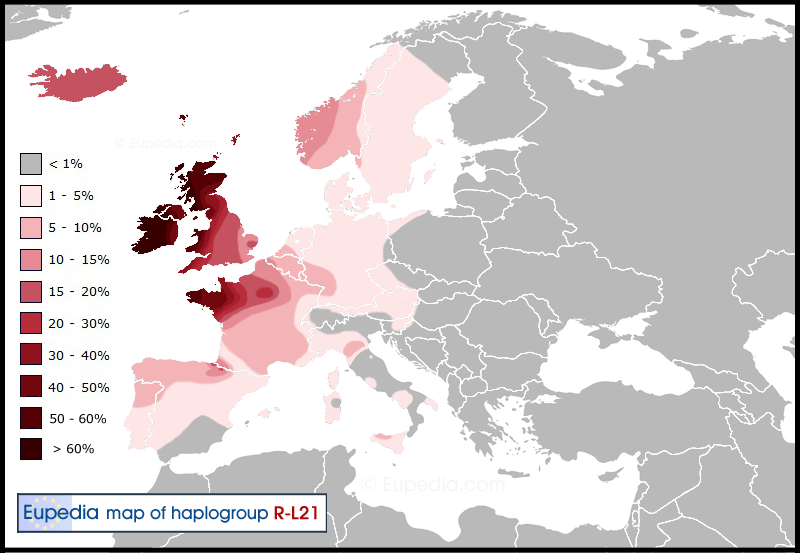Fire Haired
Regular Member
- Messages
- 689
- Reaction score
- 32
- Points
- 0
- Ethnic group
- Celto-Germanic, Latino(~6%)
- Y-DNA haplogroup
- R1b Df27(Spain)
- mtDNA haplogroup
- U5b2a2(Prussia)
R1b1a2a1a2a Df27 and R1b1a2a1a2c L21 are far western Italo Celtic R1b1a2a1a2 P312/S116 subclades while R1b1a2a1a2b S28 would be the eastern one.(spread of R1b L11 Germanic Italo Celts in western Europe) Eupedia R1b Df27 map only counts deep subclades M153 and and SRY2627. But if u add the R1b S28 and L21 in western and central France it takes up about 20-30% of total Y DNA but R1b P312/S116 is about 60-70% or >75% according to Eupedia's map. So that leaves out about 40% to other R1b P312 or R1b P312* for western France and 10-20% for the rest of France and 5-20% in western Germany. It makes sense that R1b Df27 is the main R1b P312 subclade of western France and is around 10% all the way to central Germany. Also for R1b P312 is the British isles Highlands of Scotland, Ireland, Wales, and Cornwall(last areas in Europe with Celtic languages) R1b P312 according to Eupedia map is about >75%. But their main subclade R1b L21 is only 50-60% and >60% and R1b S28 is about 1-5% so that leaves out about 10-20% or so to other R1b P312 I would think mainly R1b Df27. Also R1b L21 is very spread out in western Europe not just the British isles.

According to FTDNA R1b L21 age estimate is 5,500-4,000 years old. It probably migrated to the British isles with Celtic languages around 3,500-4,500ybp. I think that R1b Df27 expanded around the same time but I don't know of any age estimates on it. I don't completely trust the exact years or whatever of age estimates but I defintley do consider them a lot. Since R1b S28 obvisouly shows connections with the spread of Urnfield culture 3,300-3,000ybp starting in central Europe forming into Celtic Hallstat and migrating to Italy with Italic languages. Since R1b Df27 seems to have been in France and Iberia before R1b S28 and R1b L21 was deifntley in the British isles before Urnfield and Celtic Hallstat it makes sense R1b Df27 and R1b L21 migrations were around 3,500-4,500ybp.

According to FTDNA R1b L21 age estimate is 5,500-4,000 years old. It probably migrated to the British isles with Celtic languages around 3,500-4,500ybp. I think that R1b Df27 expanded around the same time but I don't know of any age estimates on it. I don't completely trust the exact years or whatever of age estimates but I defintley do consider them a lot. Since R1b S28 obvisouly shows connections with the spread of Urnfield culture 3,300-3,000ybp starting in central Europe forming into Celtic Hallstat and migrating to Italy with Italic languages. Since R1b Df27 seems to have been in France and Iberia before R1b S28 and R1b L21 was deifntley in the British isles before Urnfield and Celtic Hallstat it makes sense R1b Df27 and R1b L21 migrations were around 3,500-4,500ybp.

